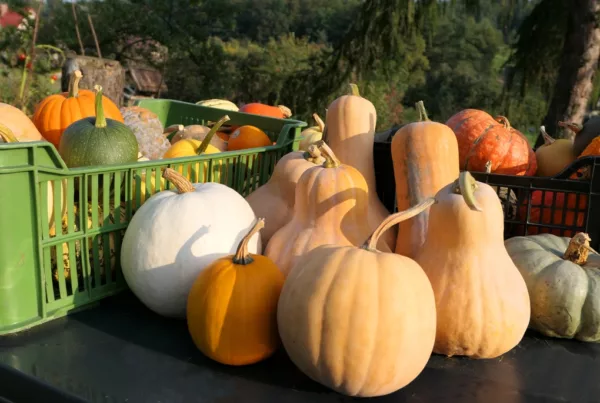Written by Chris McLaughlin
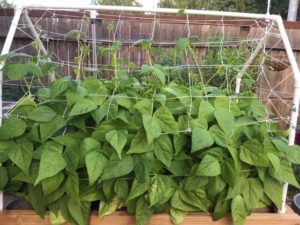
Dragon Tongue bush beans. Photo from Certified Instructor Sigrid’s SFG garden.
If you’re like me, you’re scouring seed magazines and circling those mouthwatering summer vegetables. When it comes to green beans, you pause: there are two kinds, so which to choose? Can you buy both? Each has unique traits, which can help you decide which is best for your Square Foot Garden.
Bush beans need minimal support in your garden, which makes them ideal for small spaces. The photo on the right shows how Sigrid encourages beans to grow through the netting, which keeps the plant from flopping over into your Mel’s Mix™. Plant them nine to a square. On these plants, all the beans mature around the same time so they can be harvested within a few days. If you want to put up a big batch of green beans, order this variety. However, this also means those plants are done for the season – their harvest is pretty much over. PS – Flavor-wise, some gardeners feel that bush varieties have a bit less flavor than vining beans.
Pole beans (also called climbing, vining, or runner) need a support – think netting or a trellis – as they grow UP to produce beans all season until the first hard frost. Plant these eight to a square. Check out All New Square Foot Gardening 3rd edition for ideas on climbing vegetable supports. Their nearly endless harvest makes them a great candidate for fresh eating all summer. Pole varieties often are the sweetest and most tender, and it turns out they are great for canning or freezing, too.
There are hundreds of green bean varieties, both common and exotic, available to the home gardener. Read more about growing green beans on page 212 in the All New Square Foot Gardening book.
Bush Bean Varieties
-
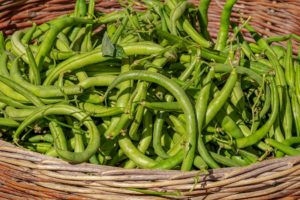
Bush beans
Contender – Productive, early producer with 6″-8″ inch stringless pods with a strong, fresh flavor. Heat and mildew tolerant. 45 days to harvest.
- Tendercrop – Also called ‘Tendergreen Improved,’ this is a heavy producer of crisp, tender, delicious pods. Well suited for northern regions. 55 days to harvest.
- Royal Burgundy – Produces 5” stringless pods. Harvest when they are a dramatic deep purple; they’ll turn green during cooking. Virus-resistant; adapts well to cool-area gardens. 60 days to harvest.
- Dragon Tongue – Grow them for the name alone, but this stringless variety is also prolific with superb flavor. Creamy-yellow, 7” pods adorned with purple streaks. 55 days to harvest.
- Maxibel – A gourmet, French “skinny” bean that produces 7”elegant pods with unbeatable flavor. 60 days to harvest.
Pole Bean Varieties
-
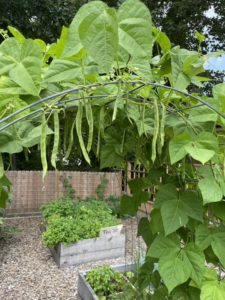
Pole beans. Photo from Certified Instructor Taylor’s SFG garden.
Blue Lake Stringless Bean – This heritage bean is a heavy producer of 5” crisp, bold-flavored pods. 6’-7’ feet tall. 62 days to harvest.
- Yard-Long Bean – Also called Chinese long, asparagus, or snake bean; this unique variety produces pods which are an astonishing 14–30 inches long! 8’-12’ feet tall. 80 days to harvest.
- Kentucky Wonder – Also known as ‘Old Homestead’ produces thick, meaty, stringless pods that offer fabulous flavor. Not to be confused with the bush version of Kentucky Wonder. 6’-8’ feet tall. 68–72 days to harvest.
- Rattlesnake Pole Bean – Aren’t heirloom plant names the best? Drought-tolerant Rattlesnake’s 8-12” green pods sport purple stripes. 9’-10’ tall. 65 days to harvest.
- Fortex Pole Bean – Growing to nearly a foot, Fortex produces extra-long flavorful pods. Early and very productive, the beans may be picked at 7″ in length for slender “filet” beans. 6’ tall. 70 days to harvest.

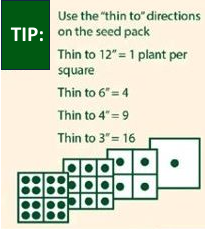 Learn more about the Square Foot Gardening Method by taking the
Learn more about the Square Foot Gardening Method by taking the 

